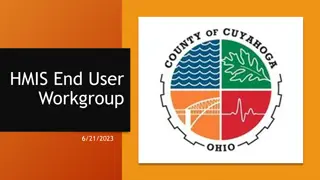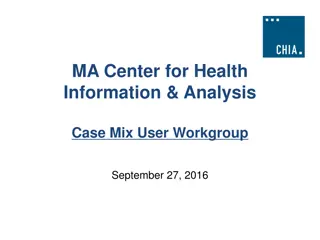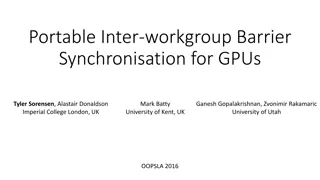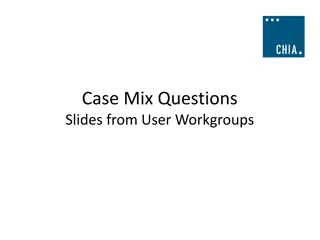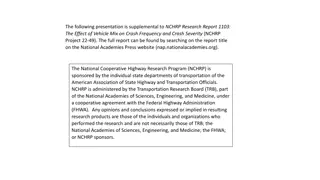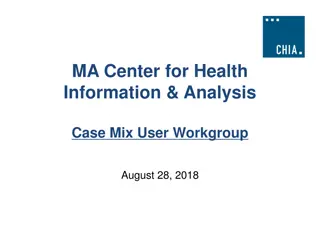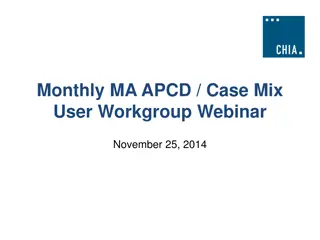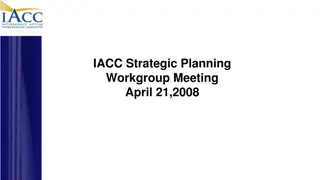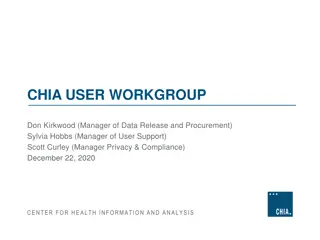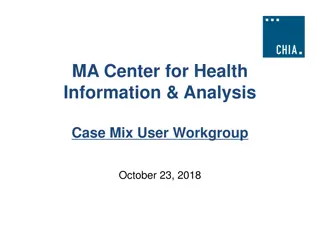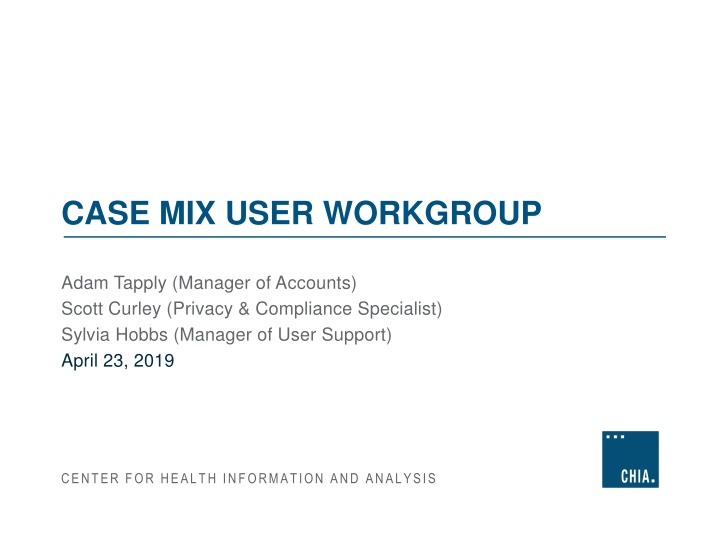
Release Timelines and Updates for Case Mix User Workgroup
Stay updated on the FY17 and FY18 Case Mix releases, timelines, user questions, and compliance details discussed at the Case Mix User Workgroup meeting on April 23, 2019. Learn about the availability of MA APCD Release 7.0 and important information for new and repeat applicants.
Uploaded on | 0 Views
Download Presentation

Please find below an Image/Link to download the presentation.
The content on the website is provided AS IS for your information and personal use only. It may not be sold, licensed, or shared on other websites without obtaining consent from the author. If you encounter any issues during the download, it is possible that the publisher has removed the file from their server.
You are allowed to download the files provided on this website for personal or commercial use, subject to the condition that they are used lawfully. All files are the property of their respective owners.
The content on the website is provided AS IS for your information and personal use only. It may not be sold, licensed, or shared on other websites without obtaining consent from the author.
E N D
Presentation Transcript
CASE MIX USER WORKGROUP Adam Tapply (Manager of Accounts) Scott Curley (Privacy & Compliance Specialist) Sylvia Hobbs (Manager of User Support) April 23, 2019 CENTER FOR HEALTH INFORMATION AND ANALYSIS
Agenda Announcements: Updates on FY17 Case Mix Release Timeline for FY18 Case Mix Release APCD Release 7.0 DUA, Compliance, and Audit Overview User Questions: Identifying mood disorder drugs in Case Mix; Quality of Hispanic data / indicator field in Case Mix; Gunshot wound injury data in Observation data; Reliability of the "Veteran Status" indicator Q&A 2 Case Mix User Workgroup | CHIA User Support | 4/23/19
Case Mix FY17 Release *CURRENT* RELEASE TIMEFRAMES FOR EACH FILE: Inpatient (HIDD) June [Completed] Emergency Department (ED) November [Completed] Outpatient Observation (OOD) February [Completed] 3 Case Mix User Workgroup | CHIA User Support | 4/23/19
Case Mix FY18 Release *CURRENT* RELEASE TIMEFRAMES FOR EACH FILE: Inpatient (HIDD) June Emergency Department (ED) August Outpatient Observation (OOD) September 4 Case Mix User Workgroup | CHIA User Support | 4/23/19
Case Mix FY18 Release REPEAT APPLICANTS: For those applicants with previously approved projects who indicated they would like to receive data annually, we began accepting Certificates of Continued Need and Compliance (Exhibit B of your DUA) starting on May 1st. After receiving this, we will send you an invoice for the FY18 data and release data to you once payment is received and the data is ready. If you are making any changes to your project, you must go through the amendment process first. 5 Case Mix User Workgroup | CHIA User Support | 4/23/19
Case Mix FY18 Release NEW APPLICANTS / NEW PROJECTS: We will continue to accept new applications on a rolling basis. If you are requesting FY18 data, just click the box for Subscription on p. 3 of the application form: 6 Case Mix User Workgroup | CHIA User Support | 4/23/19
MA APCD Release 7.0 Available NOW Encompasses data from January 2013 December 2017 with six months of claim runout (includes paid claims through 6/30/18) Release Documentation and Data Specifications have been posted to the website: http://www.chiamass.gov/ma-apcd/ Apply now by listing 2017 (and any other years you want from Release 7.0) in the Years Requested section of the current application form Available here: http://www.chiamass.gov/application-documents Additional Release 7.0 details and highlights can be found in the January 2018 APCD User Workgroup presentation available here: http://www.chiamass.gov/ma- apcd-and-case-mix-user-workgroup-information/ 7 Case Mix User Workgroup | CHIA User Support | 4/23/19
DUA, COMPLIANCE, AND AUDIT OVERVIEW
Data Use Agreements Prior to the release of data, Data Applicants must have a CHIA Data Use Agreement executed. CHIA does not accept revisions or comments to its Data Use Agreement. Data Applicants should consult their legal, compliance, Research Administration, or Sponsored Programs office about the terms and conditions of CHIA s Data Use Agreement before they submit a Data Application to CHIA for review. Data Applicants should consult these offices to determine if its organization has a current Data Use Agreement with CHIA, prior to submitting a Data Application to CHIA for review.
Compliance It is the responsibility of each organization holding CHIA Data to: Monitor responsible parties (Investigators, Data Custodians, IT) compliance with the Data Use Agreement requirements. Assess each instance of suspected or alleged non- compliance and, where appropriate, conduct investigation. Actively pursue non-compliance with a range of technical, administrative and educational response options. Inform CHIA immediately of any Data Use Agreement violation.
Compliance Your obligations, in accordance with the Data Use Agreement, include but are not limited to the following: Anyone who comes into contact with the data Must sign the confidentiality agreement All individuals, whether they are employees, contractors or agents of your organization, who have accessed or used the data, must sign a Confidentiality Agreement. All such individuals must sign the Confidentiality Agreement prior to accessing CHIA Data. You must keep the original signed Confidentiality Agreements on file. Access means the ability, or the means necessary, to read, write, modify, or communicate data/information or otherwise use any system resource.
Compliance Your obligations, in accordance with the Data Use Agreement, include but are not limited to the following: Must be added to Organization s Access Log Anyone who uses the data Your organization is required under the terms of the Data Use Agreement to create and maintain data access logs. Maintain an up-to-date access log of individuals who use or access the Data, including the date they signed the Confidentiality Agreement, when they were granted access to the Data, and when (if applicable) their access to the Data was terminated.
Compliance Your obligations, in accordance with the Data Use Agreement, include but are not limited to the following: Must Abide by the Data Management Plan Prevent Unauthorized Use or Access You are required to establish appropriate administrative, technical, and physical safeguards. You are required to abide by the Data Management Plan, as approved by CHIA and incorporated into each Data Application, at all times during the Agreement. Data may not be transmitted, disclosed or physically moved from the site(s) approved by CHIA, except as authorized by your Data Use Agreement or Data Management Plan. If your organization plans to make any change that may impact the security or integrity of the Data (i.e. a change to any of the information security, encryption, technical and physical controls) you are required to request and receive prior approval from CHIA in writing.
Compliance Your obligations, in accordance with the Data Use Agreement, include but are not limited to the following: Must Abide by the objectives and research as described in the Data Application Ensure that Data is used solely for the Project Each Data Application sets forth a specific project for which the Data will be used and that project s purpose and objective. The Data released under a Data Application may be used solely for the Project set forth in that Data Application. Absent express written authorization from CHIA, the Recipient shall not attempt to link records included in the Data to any other information. The Recipient shall not use the Data to attempt to identify individuals.
Compliance Your obligations, in accordance with the Data Use Agreement, include but are not limited to the following: Must File the Certification of Project Completion and Data Destruction with CHIA Upon Completion of Project Upon completion of the approved research project (as described in the approved Data Application), data Recipients are responsible for promptly complying with specific obligations under the Data Use Agreement, including: Destruction of the Data in accordance with the requirements of the Data Use Agreement, and Completion and return of a Certificate of Project Completion and Data Destruction. Data destruction, of original extracts and any complete or partial copies thereof, must comply with the requirements of M.G.L. c. 93 I.
CHIA Data Use Agreement Audits In accordance with the Data Use Agreement, Recipients are required to promptly respond to any request by CHIA to verify a Recipient s compliance with the terms of the Data Use Agreement Data Recipients are also responsible to secure, monitor and report on the compliance of any agent, contractor or third party to whom the Recipient disclosed CHIA Data. In 2015 CHIA began conducting formal audits of all Recipients of CHIA Data. These audits may be in the format designate by CHIA. To this point, audits have been in written form designed to get essential information while minimizing the burdens on Data Recipients. The goal of these audits is to ensure that data is used as allowed under a Data Application and is security as required under the Data Use Agreement and Data Management Plan. Responses to date have been varied, but some responses have indicated that better understanding of the Data Use Agreement and increase attention to compliance are needed.
General Areas of Non-Compliance Timeliness: Recipients should be able to substantively respond to an Audit request within ten (10) business days. Data Access Log: Incomplete or insufficient information. Confidentiality Agreements: Lack of executed Confidentiality Agreements for current and past employees. Security: Unauthorized transmittal of data; Data may note be physically moved, transmitted or disclosed in any way from or by the site approved by CHIA. Unsecured transmittal of data; the use unsecured telecommunications, including the Internet, to transmit individually identifiable or deducible information derived from the Data is prohibited. Publication: Violation of CHIA Cell Suppression policy. Unauthorized use.
General Areas of Non-Compliance: Issue: Lack of Confidentiality Agreements (CA) CHIA conducted an Audit of a Data Use Agreement with Hospital for a research team using CHIA Data. After review a review of the Audit materials, CHIA determined that several members of the research team had access to CHIA Data, but had not signed a CHIA Confidentiality Agreement. Root Cause: A lack of systematic controls or procedures for accessing CHIA Data. Resolution: The research team created a checklist of required action items (including signing a CA) to be completed prior to an employee being provided access to CHIA Data. The new forms are now included for that research teams onboarding process for new hires. Issue: Unsecured Transmittal of CHIA Data CHIA received from a Recipient an encrypted hard drive containing CHIA Data. Accompanying the hard drive was a printed email with the hard drive password. Encrypted media and passwords should never be transmitted together. Root Cause: Recipient s information and security policies and procedures addressed the secure storage and transmission of protected health information. However, the procedures did not contain highly specific details relevant to addressing physical handling of the mode of transmission CHIA employs. Resolution: Revision of Recipient s policies and procedures to: Make it explicit that passwords or encryption keys are never to be printed or recorded in hard copy Require the inspection of portable storage devices and accompanying material by two people, one of whom is a designated compliance lead, prior to shipment
General Areas of Non-Compliance: Issue: Improper Cell Suppression In reviewing supporting material for a Data Application renewal, CHIA discovered that a digital health company tool was revealing small cell sizes. No cell (e.g., admittances, discharges, patients, services) less than 11 may be displayed. Root Cause: Cell suppression functionality within the Recipient s software application was not applied to reports. The Recipient determined that the violation occurred due to a lack of sufficient oversight of the product manager for the software. Resolution: The Recipient implemented new policies and procedures which require additional review of reports and products by senior executives for compliance with the terms of each of its client's data use agreements prior to actual production. Issue: Unauthorized Use of CHIA Data CHIA regularly reviews for publications that cite the use of CHIA Data and requests a list of these publications as part of its auditing. On multiple occasions, CHIA has discovered publications on topics that are clearly not consistent with an approved use described in a Primary Investigator s Data Application. Resolution: CHIA demanded prompt destruction of all copies of the data released, a Certificate of Destruction, and notice be given to the institution s office of Sponsored Programs or Research Administration.
Inventory Data Inventory Certificate Submission Date Received Date Destroyed Date Data Type Study Name DUA Date Case Mix and Charge Data ED, 2004-2010 CHIA DATA APPLICATION TITLE Observation, 2004-2010 Inpatient, 2004-2010 All Payer Claims Data Release 3.0 , 2010-2013 Medical Claims Pharmacy Claims CHIA DATA APPLICATION TITLE Member Eligibility Provider Medicaid Case Mix and Charge Data Inpatient, 2010-2011 CHIA DATA APPLICATION TITLE Observation, 2010-2011 ED, 2010-2011
Access Anyone who uses the data Must be added to Organization s Access Log Signed Status on Project (active/inactive/ terminated) Data Access Level Confidentiality Agreement Date Data Access Granted Data Access Terminated Name Role on Project Study Name Action 1. CHIA DATA APPLICATION TITLE 2. CHIA DATA APPLICATION TITLE Requestor/Director Sponsored Programs NAME active no data access -- 1. CHIA DATA APPLICATION TITLE 2. CHIA DATA APPLICATION TITLE Receipient/Data Custodian/Associate Professor/PI NAME active full data access 1. CHIA DATA APPLICATION TITLE 2. CHIA DATA APPLICATION TITLE NAME Contact/Research Project Manager active full data access 1. CHIA DATA APPLICATION TITLE 2. CHIA DATA APPLICATION TITLE NAME Primary Investigator/Professor active no data access -- 1. CHIA DATA APPLICATION TITLE 2. CHIA DATA APPLICATION TITLE NAME Co-Investigator/Professor active no data access --
What Happens If Our Organization Fails an Audit? Depending on the severity of the DUA violation that was uncovered in the audit process, data Recipients may be instructed: To explain deficiencies and informally amend documentation, practices and/or oversight To formally conduct a Root Cause Analysis and submit a responsive Corrective Action Plan To remove or replace individual violators To return and/or destroy all CHIA Data and any copies thereof, and to certify the data destruction In the case of clear misconduct or misuse of CHIA Data, CHIA will consider suspension of data release to the individual researcher, as well as their host institution.
QUESTIONS SUBMITTED BY USERS
Question: I am discussing with my thesis committee the possibility of using Case Mix data and the MA APCD to study anxiety and depression. To what extent can pharmaceuticals administered for mood disorders be identified in the Case Mix data? ANXIETY & DEPRESSION Answer: Mood disorder drugs administered in the Outpatient Emergency Department visit (ED) data can be determined by the alphanumeric HCPCS and numeric CPT codes reported in the ED services table. While HCPCS alphanumeric codes provide greater detail on the drug name, specific dosage information and route of delivery (see tables 1 and 2 below), the use of alphanumeric HCPCS codes versus numeric CPT is based on payer requirements and the appropriateness of the code description. TOP DRUGS ADMINISTERED IN THE ED FOR MOOD DISORDERS TABLE 1. Examples of Drugs recorded using HCPCS Codes HCPCS Description CPT J2060 Injection, lorazepam, 2 mg 80178 Lithium J1630 Injection, haloperidol, up to 5 mg 80346 Benzodiazepines; 1-12 J3360 Injection, diazepam, up to 5 mg 80345 Barbiturates J3486 Injection, ziprasidone mesylate, 10 mg 80335 Antidepressants, tricyclic and other cyclicals; 1 or 2 J2358 Injection, olanzapine, long-acting, 1 mg 80175 Lamotrigine J0780 Injection, prochlorperazine, up to 10 mg 80159 Clozapine J2560 Injection, phenobarbital sodium, up to 120 mg 80337 Antidepressants, tricyclic and other cyclicals; 6 or more TABLE 2. Examples of Drugs recorded using CPT Codes Description In the Hospital Inpatient Discharge Data, pharmacy and drug services are reported using revenue codes 0250 through 0259 and revenue codes 0630 through 0637. The revenue codes do not provide the specific name of the drugs and drug class that you would find in the HCPCS and CPT codes. Even though the Outpatient Observation Stay data contains CPT codes, you are less likely to find therapeutic drugs administered to mood disorder patients and more likely to find those patients receiving blood, urine and toxicology screening tests.
Question: I would like to use the case mix data to study the health status of Hispanics in Massachusetts and stratify risk factors by ethnic groupings such as Puerto Rican, Mexican and Guatemalan. How reliable is the Hispanic indicator field and to what extent is information on Hispanic ethnic groups populated? Answer: In comparing the U.S. census data on the Massachusetts Hispanic population to Case Mix patients with a Hispanic indicator, the increase in the proportion of Massachusetts Hispanics seen in the census data is reflected in the Outpatient Emergency Department data (ED). See Figures 1 and 2 below. In any given year, approximately 17% of the Massachusetts census population utilize the ED. Therefore, the ED data can provide a meaningful benchmark for the population. Even though inpatient hospitalizations, occurring in approximately 6% of the population, are a rare event in comparison to ED visits, there have been no wild variations in proportions of Hispanics and non- Hispanics over an 8-year period in the inpatient discharge data. See Figure 3 below. Comparison Massachusetts Census Hispanic Population Proportion to Case Mix Fig 1. Census American Community Survey Fig 2. Outpatient Emergency Department Visits Fig 3. Inpatient Hospital Discharges Hispanic Not Hispanic Hispanic Not Hispanic Hispanic Not Hispanic 12% 16% 8% 2017 2017 2017 88% 84% 92% 11% 17% 8% 2016 2016 2016 89% 83% 92% 11% 16% 8% 2015 2015 2015 89% 84% 92% 11% 15% 8% 2014 2014 2014 89% 85% 92% 11% 15% 8% 2013 2013 2013 90% 85% 92% 10% 15% 8% 2012 2012 2012 90% 85% 92% 10% 14% 8% 2011 2011 2011 90% 86% 92% 10% 14% 8% 2010 2010 2010 90% 86% 92% Note: 2015 and 2016 show < 0.5% blank In the most recent FY2017 ED data, for the 399,302 ED visit with Hispanic indicator, 87% of the visits recorded a primary ethnicity reflecting 57 different ethnicities. Thirty-six percent of Hispanics utilizing the ED in FY2017 identified themselves as Puerto Rican, followed by 14% Dominican.
Gunshot Wound (GSW) Trauma Question: We are using the Case Mix data to analyze gunshot wound (GSW) injuries in Massachusetts. In 2016, there were GSWs in Observation Stay data. Why are there no GSWs in 2017 Observation Stay? Answer: The lack of FY2017 observation stays for gunshot wounds was paralleled by a 19% decrease in FY2017 inpatient care for gunshot wounds in the entire state and a decrease from FY2016 to FY2017 for ED dead on arrivals due to gunshot wounds and a decrease in ED deaths due to gunshot wounds. While there was a slight decrease in overall observation stay volume from FY2016 to FY2017, the use of observation stays for gunshot wounds have been on the decline and occurred mainly at one trauma center. For all other medical conditions, this same trauma center actually had an increase observation stays in FY2017.
Question: The Inpatient Hospital Discharge data contains a field called veteran status to indicate the patient s status as a U.S. military veteran. How reliable is that indicator? Answer: Over the past 5 years, on average 7.6 % of inpatient hospital discharges are coded as veterans . In Table 1 below, you will see that the largest proportion of discharges are coded as No , followed by Not Determined , and Not Applicable . In the U.S., the minimum age one can voluntarily enlist in the military without parental consent is 18 years old. Therefore, in Table 2 you will see that the age range for those coded as Not Applicable is largely the pediatric population younger than 18 years old. However, an FY2016 decrease in the overall percent of veterans (see Table 1) paralleled by a decrease in the pediatric population coded as Not Applicable (see Table 2). VETERAN STATUS Table 1. FY2013 to FY2017 Inpatient Hospital Discharge Veteran Status Code Frequency Veterans Status Code 1 2 3 4 Veterans Status Definition Yes No Not Applicable Not Determined FY 2013 Frequency 8.1% 60.9% 10.0% 21.0% FY 2014 Frequency 7.8% 60.6% 10.3% 21.3% FY 2015 Frequency 7.9% 61.6% 10.4% 20.1% FY 2016 Frequency 7.3% 60.0% 13.2% 19.5% FY 2017 Frequency 7.3% 57.3% 13.5% 21.8% Table 2. FY2013 to FY2017 Percent Not Applicable Veteran Status Less Than 18 Years Old Veterans Status Code 3 Veterans Status Definition Not Applicable FY 2013 Frequency 86.8% FY 2014 Frequency 86.9% FY 2015 Frequency 87.6% FY 2016 Frequency 70.2% FY 2017 Frequency 63.5% Overall for most years, when comparing the race and gender of Massachusetts residents classified as veterans in the Census American Community Survey to the race and gender of veterans utilizing inpatient care, the inpatient demographic profile of veterans is close to that of the Census. See Table 3 below. Table 3. Comparison of FY2015 Massachusetts Veteran Census Demographic Profile to Massachusetts Veterans Seeking Inpatient Care SEX Census 94.2% 5.8% Case Mix 93.8% 6.2% Male Female RACE 92.5% 3.9% 3.6% 94.7% 3.5% 1.8% White alone Black or African American alone All other races
Where can I find old User Workgroup Presentations? http://www.chiamass.gov/ma-apcd-and-case-mix-user-workgroup- information/ 30 Case Mix User Workgroup| CHIA User Support | 4/23/19
Questions? Questions related to MA APCD: apcd.data@state.ma.us Questions related to Case Mix: casemix.data@state.ma.us REMINDER: Please include your IRBNet ID#, if you currently have a project using CHIA data. 31 Case Mix User Workgroup | CHIA User Support | 4/23/19
Call for Topics and Presenters If there is a TOPIC that you would like to see discussed at an MA APCD or Case Mix workgroup in 2019, contact Adam Tapply [adam.tapply@state.ma.us] If you are interested in PRESENTING at an MA APCD or Case Mix workgroup in 2019, contact Adam Tapply [adam.tapply@state.ma.us] You can present remotely, or in-person at CHIA. 32 Case Mix User Workgroup | CHIA User Support | 4/23/19

